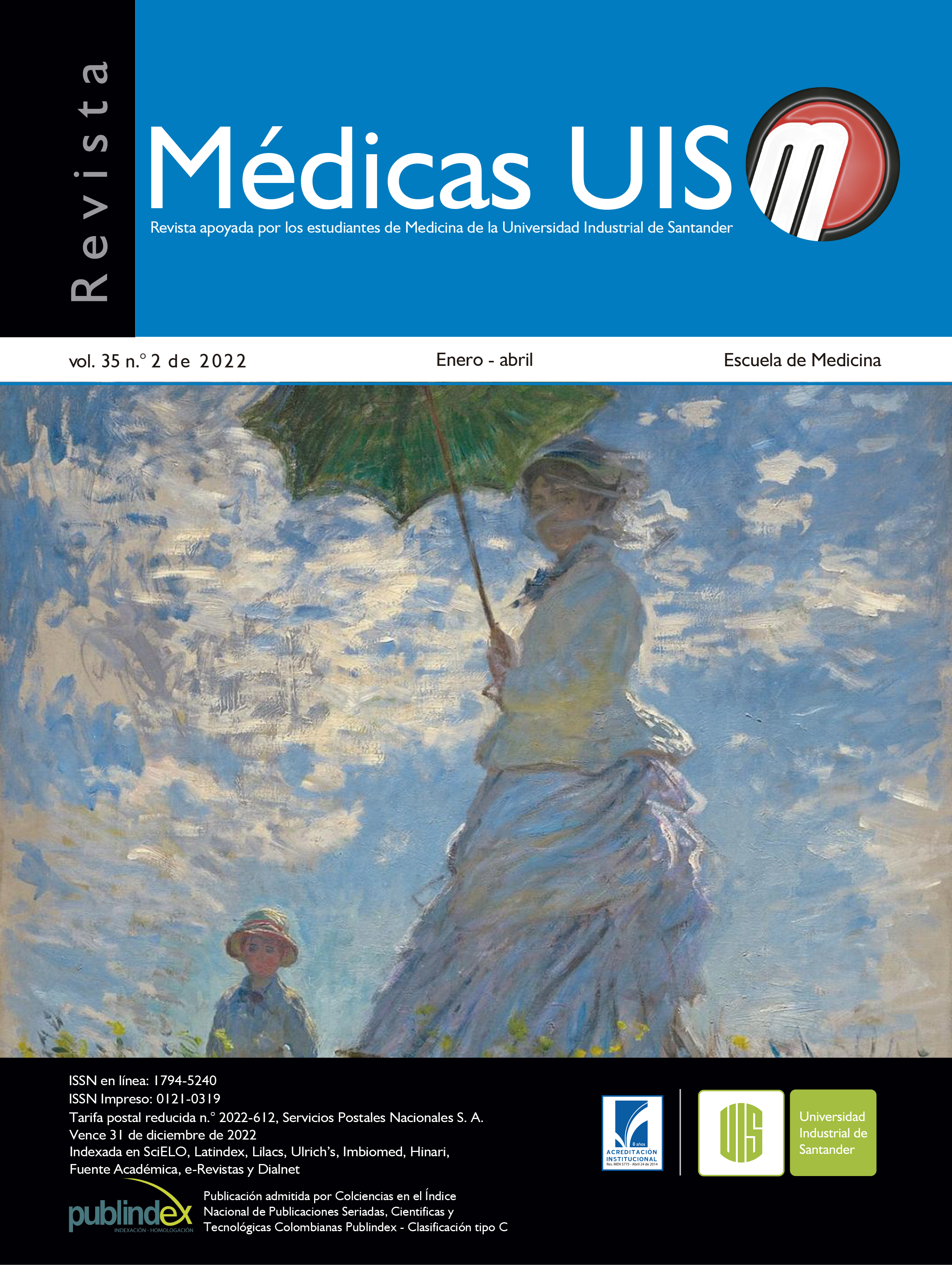Abstract
Thanatophoric dysplasia is an unusual and sporadic congenital defect whose outcome is intrauterine death or a few days
after birth. Its appearance has been described in 0.2-0.5 cases of every 10,000 live births and depends on the mutation of
the fibroblast growth factor receptor-3. It exhibits two clinical presentations, of these, the so-called type II is less frequent
and is characterized by the finding of a cloverleaf skull and micromelia with straight femurs. The following is the case of a
young multiparous pregnant woman with a finding in her first ultrasound of fetus pregnancy with general shortening of
the limbs and decreased general ossification, suggestive of thanatophoric dysplasia type II, which resulted in the voluntary
termination of pregnancy. Early diagnosis in pregnancy is important in order to guide medical practice based on the poor
prognosis of suffering from this pathology.
References
March of dimes birth defects foundation White Plains [Internet]. New York: March of Dimes Birth Defects Foundation, 2006. March of Dimes: global report on birth defects, the hidden toll of dying and disabled children; 2006. Disponible en: https://www.prevencioncongenitas.org/wp-content/uploads/2017/02/Global-report-on-birth-defects-The-hidden-toll-of-dying-and-disabled-children-Full-report.pdf.
Mortier GR, Cohn DH, Cormier-Daire V, Hall C, Krakow D, Mundlos S, et al. Nosology and classification of genetic skeletal disorders: 2019 revision. Am J Med Gen A . 2019;179(12):2393-2419.
Heath K, Sentchordi-Montané L. Displasias esqueléticas en endocrinología pediátrica: perspectiva clínica y genética. Rev Esp Endocrinol Pediatr. 2022;13(2):96-106.
Orioli IM, Castilla EE, Barbosa-Neto JG. The birth prevalence rates for the skeletal dysplasias. J Med Genet. 1986;23(4):328–32.
Barbosa-Buck CO, Orioli IM, da Graça Dutra M, Lopez-Camelo J, Castilla EE, Cavalcanti DP. Clinical epidemiology of skeletal dysplasias in South America. Am J Med Genet A. 2012;158A(5):1038–45.
DEFECTOS CONGÉNITOS COLOMBIA 2018 [Internet]. Colombia: INFORME DE EVENTO DEFECTOS CONGÉNITOS, COLOMBIA; 2018. Disponible en: https://www.ins.gov.co/buscador-eventos/Lineamientos/Pro_Defectos%20cong%C3%A9nitos%202022.pdf.
Porras-Hurtado GL, León-Castañeda OM, MolanoHurtado J, Quiceno SL, Pachajoa H, Montoya JJ. Prevalence of birth defects in Risaralda, 2010- 2013. Biomedica. 2016;36(4):556.
Wainwright H. Thanatophoric dysplasia: A review. S Afr Med J. 2016;106(6 Suppl 1): S50-3.
Goriely A, Wilkie AOM. Paternal age effect mutations and selfish spermatogonial selection: causes and consequences for human disease. Am J Hum Genet. 2012; 90(2):175–200. Disponible en: https://pubmed.ncbi.nlm.nih.gov/22325359/.
Wang DC, Shannon P, Toi A, Chitayat D, Mohan U, Barkova E, et al. Temporal lobe dysplasia: a characteristic sonographic finding in thanatophoric dysplasia. Ultrasound Obstet Gynecol. 2014;44(5):588–94.
Gilligan LA, Calvo-Garcia MA, Weaver KN, Kline-Fath BM. Fetal magnetic resonance imaging of skeletal dysplasias. Pediatr Radiol. 2020;50(2):224–33.
Chen CP, Chern SR, Shih JC, Wang W, Yeh LF, Chang TY, et al. Prenatal diagnosis and genetic analysis of type I and type II thanatophoric dysplasia. Prenat Diagn. 2001;21(2):89–95.
Martínez ML, Egüés X, Puras A, Hualde J, de Frutos CA, Bermejo E, et al. Thanatophoric dysplasia type II with encephalocele and semilobar holoprosencephaly: Insights into its pathogenesis. Am J Med Genet Part A. 2010;155(1):197-202.
Rubio S, Pacheco RA, Gómez AM, Perdomo S, García R. Secuenciación de nueva generación (NGS) de ADN: presente y futuro en la práctica clínica. Univ Med. 2020;61(2):1-15.
Chen CP, Chang TY, Lin MH, Chern SR, Su JW, Wang W. Rapid detection of K650E mutation in FGFR3 using uncultured amniocytes in a pregnancy affected with fetal cloverleaf skull, occipital pseudoencephalocele, ventriculomegaly, straight short femurs, and thanatophoric dysplasia type II. Taiwan J Obstet Gynecol. 2013;52(3):420-425.
Sharma M, Jyoti, Jain R, Devendra. Thanatophoric Dysplasia: A Case Report. J Clin Diagn Res. 2015;9(11):QD01-QD03.
Lacunza RO, Jiménez ML. Valoración ecográfica fetal en displasia esquelética, a propósito de un caso de displasia tanatofórica. Rev Peru Ginecol Obstet. 2016;62(2):247-250.
Yuvaraj MF, Sankaran PK, Raghunath G, Begum Z, Kumaresan KM. Thanatophoric Dysplasia; a Rare Case Report on a Congenital Anomaly. Int J Pediatr. 2017;5(1):4227-4231.
Fuentes F, Oliva E, Clavelle R, Doren A, De la Fuente G. Displasias esqueléticas: Reporte de un caso y revisión de la literatura. Rev Chil Obstet Ginecol. 2018;83(1):80-85.
Harris BS, Bishop KC, Kemeny HR, Walker JS, Rhee E, Kuller JA. Risk Factors for Birth Defects. Obstet Gynecol Surv. 2017;72(2):123-135.
Nazer H, Cifuentes L, Águila A, Ureta P, Bello MP, Correa F, et al. Edad materna y malformaciones congénitas. Un registro de 35 años. 1970-2005. Rev Méd Chile. 2007;135(11):1463-1469.
Urhoj DK, Mortensen LH, Nybo AM. Advanced Paternal Age and Risk of Musculoskeletal Congenital Anomalies in Offspring. Birth Defects Res B. 2015;104(6):273-280.
Miller E, Blaser S, Shannon P, Widjaja, E. Brain and bone abnormalities of thanatophoric dwarfism. AJR Am J Roentgenol. 2009;192(1):48–51.
Zhen L, Pan M, Han J, Yang X, Liao C, Li DZ. Increased first-trimester nuchal translucency associated with thanatophoric dysplasia type 1. J Obstet Gynaecol. 2015;35(7):685-7.
Ngo C, Viot G, Aubry MC, Tsatsaris V, Grange G, Cabrol D, et al. First-trimester ultrasound diagnosis of skeletal dysplasia associated with increased nuchal translucency thickness. Ultrasound Obstet Gynecol. 2007;30(2):221-6.
Grande M, Arigita M, Borobio V, Jimenez JM, Fernandez S, Borrell A. First-trimester detection of structural abnormalities and the role of aneuploidy markers. Ultrasound Obstet Gynecol. 2012;39(2):157-63.
Jung M, Park SH. Genetically confirmed thanatophoric dysplasia with fibroblast growth factor receptor 3 mutation. Exp Mol Pathol. 2017;102(2):290-295.
Reece E, Hobbins J. Obstetricia clínica. 3ª ed. Buenos Aires: Médica Panamericana; 2010.
Faye-Petersen OM, Knisely AS. Neural arch stenosis and spinal cord injury in thanatophoric dysplasia. Am J Dis Child. 1991;145(1):87-9.
Baker KM, Olson DS, Harding CO, Pauli RM. Longterm survival in typical thanatophoric dysplasia type 1. Am J Med Genet. 1997;70(4):427-36.
National Center for Biotechnology Information (NCBI) [Internet]. Treasure Island (FL): StatPearls Publishing; 2022 Jan. Available from: https://www.ncbi.nlm.nih.gov/books/NBK448166/.
Ministerio de Salud y Protección Social [Internet]. Bogotá: Ministerio de Salud y Protección Social. Interrupción voluntaria del embarazo (IVE); [aprox. 1 p.]. Disponible en: https://www.minsalud.gov.co/proteccionsocial/Paginas/Derechos-en-salud-sexual-y-reproductiva.aspx.

This work is licensed under a Creative Commons Attribution 4.0 International License.
Copyright (c) 2022 Médicas UIS
